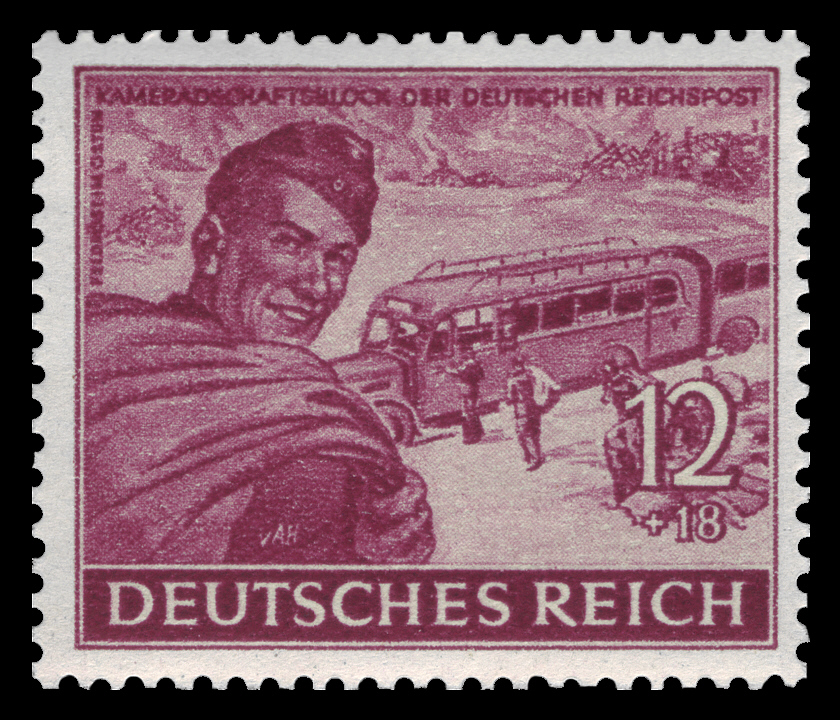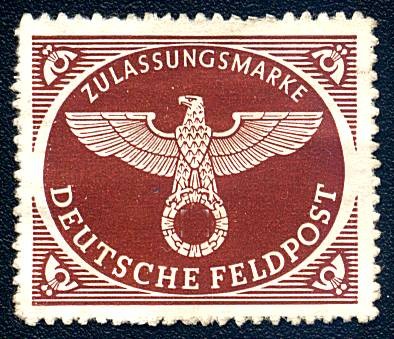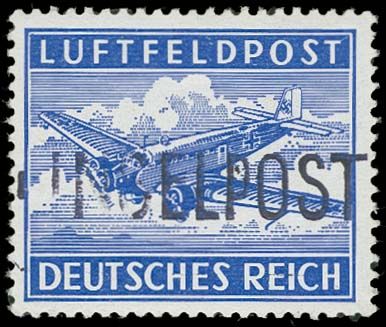


2eGM 1939 Briefkasten Feldpost St Laurent
English Translation
 |
Historique Voir ICI
History Click HERE
At Deutsche Feldpost in World War II, a distinction between military field post mail which has been sent by Wehrmacht services and carried the imprint of the letter stamp or official seal on the outside and the private consignments of the Wehrmacht as a sender or receiver, which were sent in personal affairs. She was fully a part of the Wehrmacht, the former dependence in post technical questions of the imperial postal service had disappeared
 |
The circle of beneficiaries consisted not only of the members of the three armed services Army, Air Force and Navy on active duty, but also from the SS available troops of the SS Death's Head units, police divisions and the other independent associations of SS available troops. Civilians who were treated as members of the Wehrmacht (§ 35 of the Military Law of 21 May 1935) and the members of the Reich Labour Service, which were used in the operation area in the service of the Armed Forces (to this group also included individuals who were in a service relationship with the armed forces' and received at their accommodation and meals), the field post could also use. Condition was the allocation of a field post number to the unit or the department for the use of an open address the accommodation and food by the Wehrmacht in nature or daily allowances, etc. was crucial.
Approved were ordinary postcards and letters (up to 250 g) packet (up to 1 kg), postal and money orders into the field to 1,000 RM, postal orders and payment cards from the field to 1,000 RM, some newspapers Field Post newspaper parcels and telegrams. Weight excesses were tolerated for letters up to 25 g and 100 g packet to. Military services were also able to send even post under registered or insured letter, as well as packages. Completely excluded were postal orders, postal COD, direct mail, letters Zustellungsurkunde, return receipt mail and telegraphic money orders.
For private programs following fees were collected: Packages up to 1,000 g 20 RPf. For postal and money orders into the field, Feldpost instructions and box number cards from the field and telegrams the usual domestic fee. For newspapers, half of the fee order was placed the Publisher invoiced. Newspaper bundles cost 20 RPf. each started kilograms. Parcel from the homeland had to be cleared, packages in the home should be cleared. Only the simple loss was then collected, this was also true for parcels within the Wehrmacht.
All shipments had to bear the endorsement "Feldpost" and the exact address of the sender. On shipments of departments and members of units with camouflaged address could be used as the sender's address only the field postal address. The field mailings of Wehrmacht soldiers had to be taken to a post office box or provided with letter stamp or stamp imprint of the unit are delivered to a post office to be forwarded by this same unit either. The admission in the mailboxes was limiting.
Programs that did not meet these conditions, such as normal shipments were occupied with the fees of the public postal service. The address of the consignments to the soldiers rank and name of recipient had to be given to either the five-digit field number or postal address for open full service address of his army unit.
Programs with the private address of the recipient subject to the public charge. These regulations came into force on 1 April 1940.
Soon, the weight was reduced for war letters to 100 g. Private mail box over 100 g to 250 g were now free of postage as a package. Packet 250 g to 1 kg cost further 20 RPF. But it was quite possible that the packet traffic for some time has been set fully towards the front or towards the home or at all, the official journal repeatedly reported about it. It seems that this dispatch was not entirely without problems. In December 1940, the weight was raised for the postage-paid transportation to 275 g
ccording to records of the Reich Postal Ministry are at war army postal shipments to and sent from the field by the millions: [2]
1939: 1,167
1940: 3,736
1941: 5,994
1942: 7,205
1943: 7,652
1944: 4,867
 |